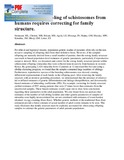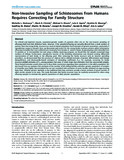| dc.contributor.author | Steinauer, ML | |
| dc.contributor.author | Christie, MR | |
| dc.contributor.author | Blouin, MS | |
| dc.contributor.author | Agola, LE | |
| dc.contributor.author | Mwangi, IN | |
| dc.contributor.author | Maina, GM | |
| dc.contributor.author | Mutuku, MW | |
| dc.contributor.author | Kinuthia, JM | |
| dc.contributor.author | Mkoji, GM | |
| dc.contributor.author | Loker, ES | |
| dc.date.accessioned | 2013-10-11T09:09:15Z | |
| dc.date.available | 2013-10-11T09:09:15Z | |
| dc.date.issued | 2013 | |
| dc.identifier.citation | PLoS Negl Trop Dis. 2013 Sep 19;7(9):e2456. | en |
| dc.identifier.uri | http://www.ncbi.nlm.nih.gov/pubmed/24069499 | |
| dc.identifier.uri | http://erepository.uonbi.ac.ke:8080/xmlui/handle/123456789/57593 | |
| dc.description.abstract | For ethical and logistical reasons, population-genetic studies of parasites often rely on the non-invasive sampling of offspring shed from their definitive hosts. However, if the sampled offspring are naturally derived from a small number of parents, then the strong family structure can result in biased population-level estimates of genetic parameters, particularly if reproductive output is skewed. Here, we document and correct for the strong family structure present within schistosome offspring (miracidia) that were collected non-invasively from humans in western Kenya. By genotyping 2,424 miracidia from 12 patients at 12 microsatellite loci and using a sibship clustering program, we found that the samples contained large numbers of siblings. Furthermore, reproductive success of the breeding schistosomes was skewed, creating differential representation of each family in the offspring pool. After removing the family structure with an iterative jacknifing procedure, we demonstrated that the presence of relatives led to inflated estimates of genetic differentiation and linkage disequilibrium, and downwardly-biased estimates of inbreeding coefficients (FIS). For example, correcting for family structure yielded estimates of FST among patients that were 27 times lower than estimates from the uncorrected samples. These biased estimates would cause one to draw false conclusions regarding these parameters in the adult population. We also found from our analyses that estimates of the number of full sibling families and other genetic parameters of samples of miracidia were highly intercorrelated but are not correlated with estimates of worm burden obtained via egg counting (Kato-Katz). Whether genetic methods or the traditional Kato-Katz estimator provide a better estimate of actual number of adult worms remains to be seen. This study illustrates that family structure must be explicitly accounted for when using offspring samples to estimate the genetic parameters of adult parasite populations. | en |
| dc.language.iso | en | en |
| dc.title | Non-invasive sampling of schistosomes from humans requires correcting for family structure. | en |
| dc.type | Article | en |
| local.publisher | College of Osteopathic Medicine of the Pacific Northwest, Western University of Health Sciences, Lebanon, Oregon, United States of America. | en |


